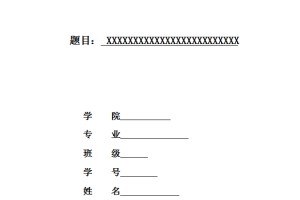摘 要
USB(Universal Serial Bus)是一种新型的通用串行总线,它是快速的、双向的、同步的、可以热插拨的、动态连接且价格低廉的串行接口。正是基于这一特点,现在很多的计算机外设都有USB接口。本文正是利用这一新型USB接口来设计上位机与下位机系统之间的通信。利用新型的一线式数字温度传感器测量温度,并通过USB接口和计算机端应用软件进行通信。
本文首先介绍了本系统相关的背景知识以及USB的通信协议,进而介绍温度控制的基本意义,提出利用USB设备芯片CH372、一线式数字温度传感器DS18B20和单片机AT89C51来开发基于USB温度控制系统。采集的温度数据通过USB接口上传到上位PC机上,并利用应用软件对其进行处理。上位机应用软件用C ++ builder 编写,其运用CH372接口芯片的动态链接库建立起上位机和下位机之间的通信机制。上位机将采集到的温度数据在PC机上显示出来,并且显示实时温度采集图像。
此外,应用软件可以对下位机进行温度极限设置等简单控制功能,当采集到的温度超过某一设定极限温度,则对系统进行报警。另外下位机还为今后的扩展保留一定的资源。
关键词: AT89C51;USB协议; 温度采集 ;一线式温度传感器 ;CH372
Abstract
USB (Universal Serial Bus) is a kind of new Universal Serial Bus, it is a serial bus which is very fast, dual channel, synchronous, can be pulled and plugged with the power on (Hot Swap), can be connected dynamically and very cheap. Because of this characteristic, nowadays, a great many type of computers have USB interface. The project presented in this dissertation used this new USB interface to design the communication between upper computer and down computer system. With the one wire temperature sensor, I measure the temperature and communicate with the computer application through the USB interface.
At the beginning of this dissertation, some basic knowledge about the system and communication protocol of USB (Universal Serial Bus) will be described, and later, introduced the basic meaning of temperature control, This dissertation also brought forward this idea: to develop the temperature control system which is base on the USB, and those tools the system will need are USB device chip CH372, one wire digital temperature sensor DS18B20 and single chip AT89C51.The temperature system got will upload to the upper computer’s application through USB interface. The upper computer’s application is programmed in the environment of C++ builder; the software I programmed used the DLL (dynamic link library) of CH372 and built the communication system between upper computer and down computer. The upper computer will display the temperature got by the sensor, and display the data on the screen of the PC, and display the temperature acquisition graphics simultaneously.
Besides, the applications on the upper computer can control the down computer to set the temperature limits, things like this, when the temperature exceed a temperature set in advanced, the system will alert. The down computers also keep some resources for future extensions.
Keywords: AT89C51; USB specification; temperature acquisition; one wire temperature sensor; CH372
目 录
引言···························································································· 1
1 背景知识················································································ 1
2 系统概述················································································ 2
2.1 系统的特性································································································ 2
2.2 系统的功能······························································································· 2
2.3 系统开发平台····························································································· 2
3 系统总体设计·········································································· 3
3.1 系统整体方框图·························································································· 3
3.2 系统方案比较····························································································· 3
3.2.1系统两种可行方案···················································································· 3
3.2.2方案最终选择·························································································· 4
4 系统硬件设计·········································································· 5
4.1 中央处理器—-AT89C51·············································································· 5
4.2 温度传感器DS18B20···················································································· 8
4.3 温度采集模块电路设计·············································································· 13
4.4 系统接口模块电路设计·············································································· 15
4.4.1 USB简介······························································································· 15
4.4.2 USB芯片选择························································································· 16
4.4.3 USB设备端接口设计··············································································· 18
4.5 系统硬件整体实现····················································································· 20
5 系统软件设计········································································ 20
5.1 软件设计工具··························································································· 20
5.2 系统软件设计··························································································· 21
5.2.1下位机的软件设计·················································································· 21
5.2.2上位机的软件设计·················································································· 24
6 系统调试··············································································· 25
6.1 硬件调试·································································································· 25
6.2 软件调试·································································································· 26
6.2.1 下位机的软件调试·················································································· 26
6.2.2 上位机的软件调试·················································································· 27
6.2.3 上位机和下位机联机调试········································································ 28
6.3 系统性能指标··························································································· 29
7 系统的简单操作说明······························································ 29
8 总结······················································································ 29
谢辞··························································································· 31
参考文献···················································································· 32
附录··························································································· 33





